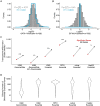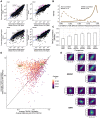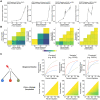This is a preprint.
Transcriptome-wide characterization of genetic perturbations
- PMID: 39005298
- PMCID: PMC11244993
- DOI: 10.1101/2024.07.03.601903
Transcriptome-wide characterization of genetic perturbations
Update in
-
Transcriptome-wide analysis of differential expression in perturbation atlases.Nat Genet. 2025 May;57(5):1228-1237. doi: 10.1038/s41588-025-02169-3. Epub 2025 Apr 21. Nat Genet. 2025. PMID: 40259084
Abstract
Single cell CRISPR screens such as Perturb-seq enable transcriptomic profiling of genetic perturbations at scale. However, the data produced by these screens are often noisy due to cost and technical constraints, limiting power to detect true effects with conventional differential expression analyses. Here, we introduce TRanscriptome-wide Analysis of Differential Expression (TRADE), a statistical framework which estimates the transcriptome-wide distribution of true differential expression effects from noisy gene-level measurements. Within TRADE, we derive multiple novel, interpretable statistical metrics, including the "transcriptome-wide impact", an estimator of the overall transcriptional effect of a perturbation which is stable across sampling depths. We analyze new and published large-scale Perturb-seq datasets to show that many true transcriptional effects are not statistically significant, but detectable in aggregate with TRADE. In a genome-scale Perturb-seq screen, we find that a typical gene perturbation affects an estimated 45 genes, whereas a typical essential gene perturbation affects over 500 genes. An advantage of our approach is its ability to compare the transcriptomic effects of genetic perturbations across contexts and dosages despite differences in power. We use this ability to identify perturbations with cell-type dependent effects and to find examples of perturbations where transcriptional responses are not only larger in magnitude, but also qualitatively different, as a function of dosage. Lastly, we expand our analysis to case/control comparison of gene expression for neuropsychiatric conditions, finding that transcriptomic effect correlations are greater than genetic correlations for these diagnoses. TRADE lays an analytic foundation for the systematic comparison of genetic perturbation atlases, as well as differential expression experiments more broadly.
Conflict of interest statement
Declaration of Interests J.S.W. declares outside interest in 5 AM Venture, Amgen, Chroma Medicine, KSQ Therapeutics, Maze Therapeutics, Tenaya Therapeutics, Tessera Therapeutics, Ziada Therapeutics and Third Rock Ventures. J. M. R. consults for Third Rock Ventures and Maze Therapeutics, and is a consultant for and equity holder in Waypoint Bio.
Figures






References
-
- Binan Loïc, Danquah Serwah, Valakh Vera, Simonton Brooke, Bezney Jon, Nehme Ralda, Cleary Brian, and Farhi Samouil L.. 2023. “Simultaneous CRISPR Screening and Spatial Transcriptomics Reveals Intracellular, Intercellular, and Functional Transcriptional Circuits.” bioRxiv : The Preprint Server for Biology, December. 10.1101/2023.11.30.569494. - DOI - PMC - PubMed
-
- Binder Janos X., Pletscher-Frankild Sune, Tsafou Kalliopi, Stolte Christian, O’Donoghue Seán I., Schneider Reinhard, and Jensen Lars Juhl. 2014. “COMPARTMENTS: Unification and Visualization of Protein Subcellular Localization Evidence.” Database: The Journal of Biological Databases and Curation 2014 (February): bau012. - PMC - PubMed
Publication types
Grants and funding
LinkOut - more resources
Full Text Sources
